Seagate GoFlex Home 2TB Reviewed
by Rajinder Gill on October 10, 2010 5:05 PM ESTThe GoFlex ships with a driver CD supporting both Microsoft Windows and Apple’s Mac OS. Seagate uses an Axentra based OS with a front end provided by Memeo for software control of the GoFlex drive (we’re testing the Windows version here):
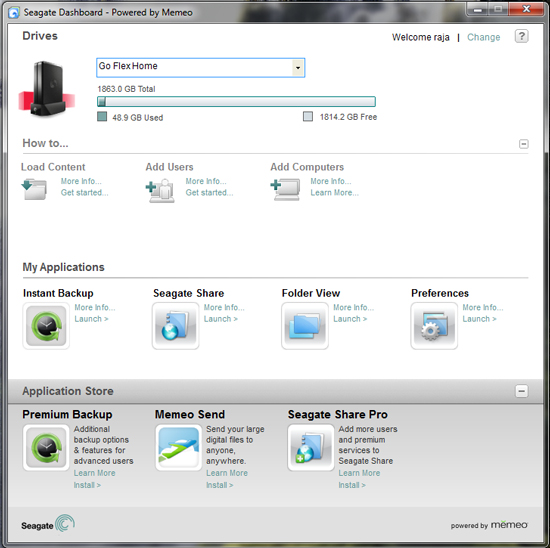
First-time setup is painless, the software will prompt you to setup a master account (mandatory for access), install the Seagate Dashboard user utility to the system tray and then proceed to map three folders to the OS:
 Media/music files placed in the Public folder are available to DLNA/iTunes by default.
Media/music files placed in the Public folder are available to DLNA/iTunes by default.
As soon as the master user account has been created, you're free to upload files to the GoFlex Home. If it's media/music streaming you're after, simply upload files into the Public folder and they'll be available on the network to DLNA and iTunes.
The Dashboard utility is supplied by Memeo, and allows complete/partial system backups, file shares, admin control and also provides a link through to Seagate’s Premium services, which allow an unlimited number of user accounts to be added at a cost of $19.99 per annum - by default only five user accounts can be created although multiple logins per account are allowed. Personally we’d have preferred it if Seagate had allowed the creation of more than five user accounts for “free” considering that we’ve got 2TB of storage on tap here.
Here's a breakdown of the features on offer in the standard and Pro versions of Seagate Share:
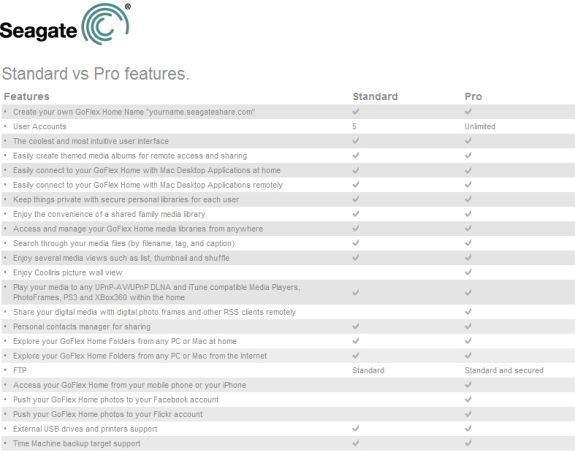
Unlimited user accounts, secure FTP and direct publishing to Facebook and Flickr accounts all come at a price...
Seagate Share
The Seagate Share web utility is accesed via Dashboard and has three options:
Share: access to personal shares (media files, directories that you’ve shared with other users).
Seagate Share: this provides the logged in user with access to the public folder as well as private and backup files under their ownership – from here one can add these to a public share folder (or create a new public share folder) for global access. This section also provides access to any USB drives plugged into the GoFlex base unit.
Preferences: Admin control for user accounts and device settings.
Most of what is needed is available in the admin control section. One thing we don’t like about the GoFlex though is that if you assign a static IP address to the unit, the settings will be lost in the event of a power cycle/power outage. True, most people won’t need to assign a manual DHCP address in a home environment, but one would expect a static IP address to hold if need be.
Remote Access
One of Seagate's key features with the GoFlex Home is that you can access the drive remotely via the internet - WWW.SeagateShare.com. Again it’s all about ease-of-use, provide the drive with a name for recognition and the software takes care of all setup criteria incuding the router for port forwarding to the GoFLex's IP address. Once at WWW.SeagateShare.com, simply enter the drive name and provide user account details, which will log you in and take you to the Seagate share screen (shown above) - it couldn't be simpler.
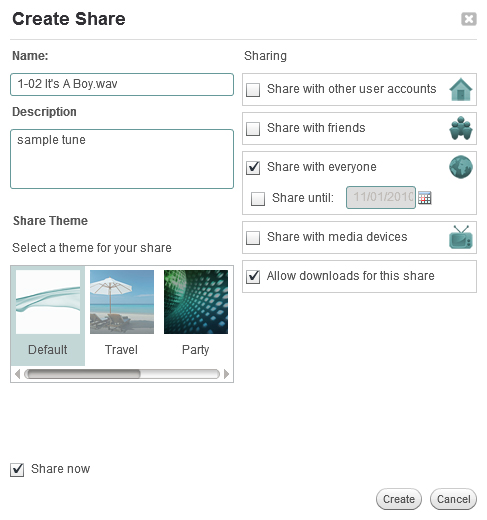
Creating a share is a doddle, the GUI is well laid out and lets you select specific users or media devices to share with. You can also make a global public share that will provide a hyperlink that you can email to friends so that they can view or download files.
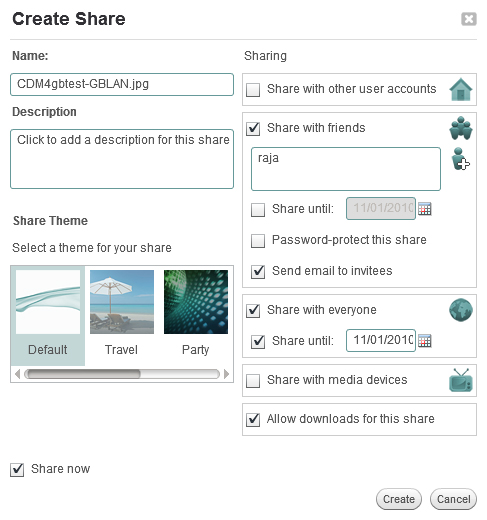
Lastly, there's Memeo Backup, which we've already covered here.


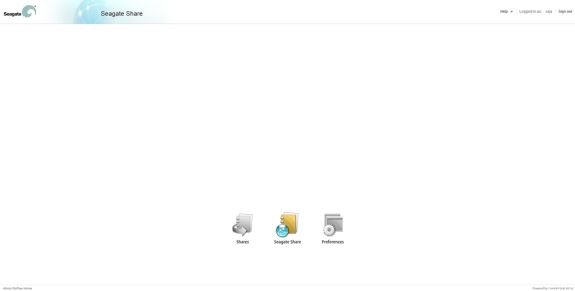
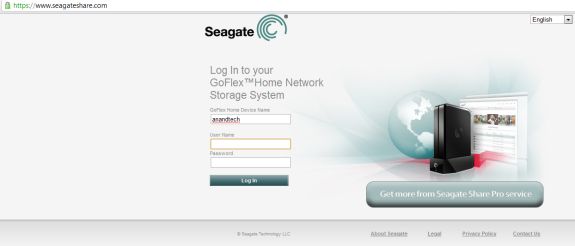








30 Comments
View All Comments
brucek2 - Sunday, October 10, 2010 - link
They mention later on that there's a GigEthernet port as well.Voldenuit - Monday, October 11, 2010 - link
WTF. Seriously?A NAS that uses a proprietary drive mounting system, charges a subscription fee to give you unlimited account access and is crippled by writes?
You could/should have completed the review with just two words: 'IT's CRAP' and tossed the damn thing into a trashcan.
I imagine something like a Synology NAS would have this thing licked in terms of features, performance and upgradability (hont: would love to see a proper review of a Synology NAS to compare). Recommending the GoFlex for *any* user (especially what amounts to uninformed general users) with little or no comparison to the rest of the market seems irresponsible to me.
Voldenuit - Monday, October 11, 2010 - link
*hint, not hont.dia - Monday, October 11, 2010 - link
If it were as bad as you imply, Small Network Builder would have arrived at a different conclusion, too. I think given the type of user this drive is aimed at it's not bad overall.http://www.smallnetbuilder.com/nas/nas-reviews/312...
HMTK - Monday, October 11, 2010 - link
You can't compare this to a Synology on features nor price.Voldenuit - Monday, October 11, 2010 - link
A Synology DS210 is $200 (bare unit) and has 2 drive bays, DLNA, RAID and bittorent functionality. The type of user who needs a NAS will probably have spare hard drives lying around and/or would appreciate not being locked into a vendor-specific configuration. Anyone who puts a 2 TB drive in a NAS probably won't appreciate slow write speeds, either.If the Synology performs to expectations (hint: review pls), it would represent much better value and be a better technical solution than the Seagate.
PS Did AT test performance under multi-client access? After all, the point of a NAS is to serve multiple users on a single network.
Duftopia - Sunday, September 14, 2014 - link
I would have agreed with you when I bought the unit. Seagate on the other hand does make A++ Hard drives which is what they are good at, they DO NOT write A++ software, nor have exceptional support (as of 2013).the $9.99 subscription was in my opinion a travesty, NO professional company like Seagate should resort to such a money grab, but after several years of use I must say the drive is an exceptional and cheap backup and streaming device (although almost always behaves as-if its on its last leg).
Duf
baba264 - Tuesday, October 12, 2010 - link
I'd be quite interested by reading reviews of other NAS units as I might be interested in buying one in the not so distant future (6 month or so).I would be interested to see what higher priced solutions have to offer and would particularly like to read about solutions that would allow RAID 5. As was said before, with these kind of solutions, it is nice to have some kind of insurance against drive failure.
Rajinder Gill - Tuesday, October 12, 2010 - link
Hi,We'll try and get some more stuff in to review - specifically enclosures offering redundancy. This is our first NAS review so there's room for improvement and we're taking all suggestions into consideration for future articles.
-Raja
Voldenuit - Tuesday, October 12, 2010 - link
Thanks Raja!Looking forward to more reviews from AT on NASes as they become more relevant to home users. Maybe even find some way to put them on Bench? ^_~ Things that I can think of offhand that would be good to know before spending $200+ on a NAS:
1. Performance under different connection protocols (100/1000/801.11n)
2. Read and write (and concurrent r+w) speeds
3. Performance scaling with multiple queues/users
4. Setup and installation
5. Compatibility with various client OSes and HDDs (Advanced format, 2 TB+ etc)
6. Administrative access
7. Features and utilities (usb printer server, http/ftp host, BT, RAID, QoS)
8. Streaming features and compatibility (xbmc, DLNA, Boxee etc etc)
9. Power, heat and noise (some NASes have tiny whirring fans, others resonate HDD noise)
You covered quite a few of these in your review, obviously the GoFlex is a very basic device compared to its peers in terms of features.
It might be interesting to set up a baseline system to compare NAS performance with a cheap DIY server like a miniITX Atom server running Linux/Windows. Especially when Bobcat trickles in.
I'm sure more suggestions will trickle in, so let me say thank you again for taking on this monumental task ;).